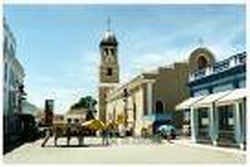Bayamo, Cuba: a culture of hygiene
- Submitted by: admin
- Health and Medicine
- Science and Technology
- 10 / 06 / 2007

City employee Francisco Arias Batista assures that many days have passed without having to pick up a piece of paper or any kind of solid waste along Bayamos promenade, the area hes in charge of cleaning.
"Its unlikely to see people throwing trash outside of the garbage bins," says this worker with more than 20 years of experience. "It wasnt like this a few years ago, but today people have the culture of hygiene. Just take a look at every street to confirm it. Thats why many visitors say that Bayamo is among Cubas cleanest cities."
Franciscos opinion is shared by locals and by other Cubans passing through the capital of Granma province, impressed with its current immaculate appearance.
The genesis of this behavior dates back to 2002, when a group of projects to promote better urban management began in Bayamo and in other Cuban cities.
The financial and methodological support for this objective came from Agenda 21 Local, a program created for this purpose as a result of the First Earth Summit, held in Rio de Janeiro, Brazil, in 1992.
In Bayamo, the program included four goals: the improvement of public areas; decontamination of the river named after the city; increased public transportation -especially the service of horse-drawn carriages as the typical and main means of transport for its residents; and the collection and processing of solid waste.
According to Felix de la Rosa, director of the municipalitys community services, this plan, included in the Local Human Development Program, made it possible to purchase 155 garbage carts and other items such as overalls and shovels for people directly linked to cleaning. It also provided some 300 garbage cans placed in permanent places, where passer-bys throw their wrappings and any other kind of solid waste.
But the availability of resources was not the only reason why the city reached its current cleanliness level.
Determining factors in this result have been the efforts made by workers and the systematic environmental education of the population.
OTHER REASONS
Enrique Domínguez González, head of the citys sanitation services, says that the work has been organized in 17 zones. He notes that the close link between community leaders of those areas and groups of city workers, and the adoption of measures to guarantee more efficiency and care of resources acquired, had a considerable bearing on these results.
The waste disposal service for the city and the neighboring towns of Julia, Mabay and Barranca includes 310 street cleaners, who work in two shifts (from 5:00 a.m. to 1:00 p.m. and from 1:00 p.m. to 9:00 p.m.).
Systematic work controls made it possible to create awareness on the need to increase efficiency, and when people see their streets clean they support this endeavor.
Thus, Bayamo has managed to keep itself clean, not only in its city center but also in residential areas. This compliments efforts to spruce up parks and increase the number of green areas per inhabitant.
However, not everything is ideal. There are still problems in garbage collection, in which the remoteness of dumping sites has had more influence than the lack of transportation, making it hard to contract horse drawn carts to compliment the insufficient garbage vehicles.
Today, Bayamo collects between 80 and 85 percent of the solid waste it generates. An increase in that indicator could be experienced after the conclusion of another project that will allow for the creation of 10 new dump sites and the placing of 60 plastic containers in the areas with more difficulties, mainly located on the northern side of the city.
A pilot project to place plastic bags of two colors in a housing project, one for un-recyclable waste and the other for waste that can be used as raw material, is another of the citys immediate plans.
If it bears fruit, this initiative will be expanded to other neighborhoods. In this way the city will continue to impress with its cleanliness, while at the same time its residents will find other ways of contributing to the local economy and to that of their nation.
Source: By Marina Sariol, Granma
Comments